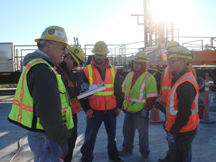Construction Safety Standards - Introduction To OSHA Quiz

This test is an introduction to Construction Safety Standards.
- 1.
What year was OSHA established?
- A.
1926
- B.
1884
- C.
1945
- D.
1970
Correct Answer
D. 1970Explanation
OSHA, the Occupational Safety and Health Administration, was established in 1970. This agency was created by the US government to ensure safe and healthy working conditions for employees. OSHA sets and enforces standards, provides training and education, and conducts inspections to promote workplace safety. The establishment of OSHA in 1970 marked a significant milestone in the history of worker protection in the United States.Rate this question:
-
- 2.
What does NIOSH stand for?
- A.
Nebraska Incorporated Occupational Safety & Health
- B.
National Institute of Occupational Safety & Health
- C.
National Independent Occupational Safety & Health
Correct Answer
B. National Institute of Occupational Safety & HealthExplanation
NIOSH stands for National Institute of Occupational Safety & Health. This organization is responsible for conducting research, providing education and training, and developing recommendations to prevent work-related injuries, illnesses, and deaths. NIOSH works closely with employers, workers, and other stakeholders to promote safe and healthy workplaces across various industries.Rate this question:
-
- 3.
If a standard does not exist within OSHA's Policy, it is at the employers discretion to perform as they see fit.
- A.
True
- B.
False
Correct Answer
B. FalseExplanation
OSHA has a General Duty Clause that states: Each employer "shall furnish a place of employment which is free from recognized hazards that are causing or likely to cause death or serious physical harm to his employees"Rate this question:
-
- 4.
If we have policies that are above and beyond OSHA standards we will only be held accountable for OSHA.
- A.
True
- B.
False
Correct Answer
B. FalseExplanation
OSHA holds us accountable for our policies. When we make a policy that is more stringent than OSHA we are held to that standard.Rate this question:
-
- 5.
How soon do we need to notify OSHA after we have a recordable injury?
- A.
2 Hours
- B.
4 Hours
- C.
24 Hours
- D.
We do not have to notify OSHA
Correct Answer
D. We do not have to notify OSHAExplanation
We only need to notify OSHA when we have a fatality or when 3 or more of our employees are hospitalized.Rate this question:
-
- 6.
Which of the following comments apply to a Competent Person requirements? Pick all that apply
- A.
Understands the OSHA standards that they are deemed competent over
- B.
Can identify the hazards in the operation
- C.
Has been designated by the company as the competent person and has the authority to take appropriate actions.
- D.
Has completed an OSHA certified training class
- E.
All of the above
Correct Answer(s)
A. Understands the OSHA standards that they are deemed competent over
B. Can identify the hazards in the operation
C. Has been designated by the company as the competent person and has the authority to take appropriate actions.Explanation
To be a competent person a knowledge of the standards and the ability to identify the hazards with the authority to take action are all requirements.Rate this question:
-
- 7.
What is the number for the Construction Safety Standards?
- A.
CFR-32
- B.
CFR-29
- C.
1926
- D.
1927
Correct Answer
C. 1926Explanation
The correct answer is 1926. This number refers to the Construction Safety Standards, which are regulations established by the Occupational Safety and Health Administration (OSHA) in the United States. These standards outline safety requirements and best practices for construction sites to ensure the well-being and protection of workers.Rate this question:
-
- 8.
We follow the Construction Safety Standards 1926 not the General Industry Standards.
- A.
True
- B.
False
Correct Answer
B. FalseExplanation
Within 1926 Construction Safety Standards there are references to 1910 General Industry Standards. We must be familiar with each.Rate this question:
-
- 9.
If an OSHA compliance officer arrives on your project you are expected to: (Pick the best answer)
- A.
Stop what you are doing and immediately take them on a field tour.
- B.
Contact your project manager or highest ranking supervisor on duty and take the officer to the office to meet with them.
- C.
Let everyone know so they can stop work and clean up.
- D.
Allow full access to the project
Correct Answer
B. Contact your project manager or highest ranking supervisor on duty and take the officer to the office to meet with them.Explanation
If an OSHA officer arrives on your site, take them to the project manager or highest ranking supervisor. If you are on a walk with them carry a camera and take photos of anything they point out or photograph. It will help us identify any problems that need to be handled.Rate this question:
-
- 10.
If OSHA issues a citation for a willful violation the cost can be up to?
- A.
$ 2,500
- B.
$ 10,000
- C.
$ 2,500
- D.
$ 70,000
- E.
$ 5,000
Correct Answer
D. $ 70,000Explanation
If OSHA issues a citation for a willful violation, the cost can be up to $70,000. This is because a willful violation is the most severe type of violation, indicating that the employer intentionally disregarded safety regulations. As a result, OSHA imposes higher penalties to deter such behavior and ensure workplace safety.Rate this question:
-
- 11.
In order to prove we provided training we need to have the proper documentation with names on sign up sheet.
- A.
True
- B.
False
Correct Answer
A. TrueExplanation
If we don't have proof we won't receive credit.Rate this question:
-
- 12.
What is the most cited violation within construction during the year of 2003?
- A.
Scaffolds
- B.
Fall Protection
- C.
Electrical
- D.
Excavations
Correct Answer
B. Fall ProtectionExplanation
Fall Protection is the most cited violation within construction during the year of 2003. This means that the majority of construction sites were found to have inadequate safety measures in place to prevent falls. This could include issues such as lack of guardrails, improper use of ladders, or failure to provide proper safety harnesses and equipment. Falls are a significant risk in the construction industry, and it is crucial for employers to prioritize fall protection to ensure the safety of workers.Rate this question:
-
- 13.
If OSHA shows up at your site it is expected that you notify the District Safety Manager.....(pick best answer)
- A.
Within 2 hours
- B.
Immediately after the visit
- C.
Immediately
- D.
Within 24 hours
Correct Answer
C. ImmediatelyExplanation
The District Safety Manager can provide some tips on making sure we are complying properly with the visit.Rate this question:
-
- 14.
Failure to correct a prior violation may bring civil penalties of up to ______ for each day the violation continues.
- A.
$ 250
- B.
$ 500
- C.
$ 2,500
- D.
$ 7,000
- E.
$ 1,000
Correct Answer
D. $ 7,000Explanation
Failure to correct a prior violation may bring civil penalties of up to $7,000 for each day the violation continues. This means that if a violation is not addressed and resolved, the responsible party may be fined up to $7,000 per day until the violation is rectified. This significant penalty serves as a deterrent and emphasizes the importance of promptly addressing and fixing any violations to avoid incurring such high fines.Rate this question:
-
Quiz Review Timeline +
Our quizzes are rigorously reviewed, monitored and continuously updated by our expert board to maintain accuracy, relevance, and timeliness.
-
Current Version
-
Mar 21, 2023Quiz Edited by
ProProfs Editorial Team -
Nov 19, 2008Quiz Created by
Kiewitsafe
- Back Safety Quizzes
- Chemistry Safety Quizzes
- Drill Press Safety Quizzes
- Electrical Safety Quizzes
- Fire Safety Quizzes
- General Safety Quizzes
- Kitchen Safety Quizzes
- Laboratory Safety Quizzes
- Lathe Safety Quizzes
- Office Safety Quizzes
- Online Safety Quizzes
- Patient Safety Quizzes
- Radiation Safety Quizzes
- Safe Lifting Quizzes
- Sander Safety Quizzes
- Saw Safety Quizzes
- Shop Safety Quizzes
- Work Safety Quizzes
- Workplace Safety Quizzes
 Back to top
Back to top











